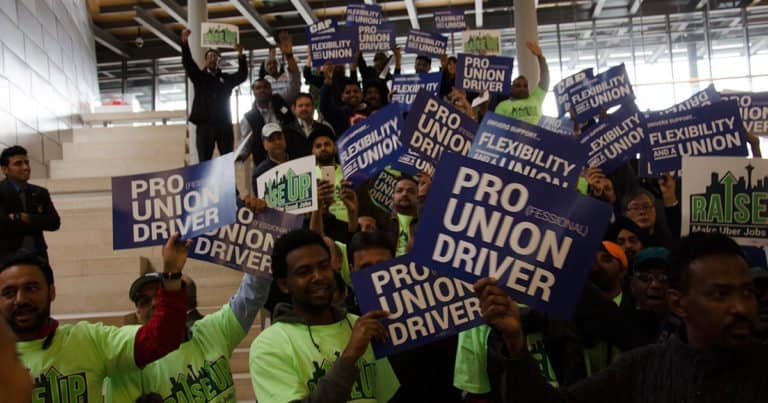Today, the Supreme Court announced its ruling in Young v. UPS, coming down 6-3 in favor of former UPS employee Peggy Young. The question at the center of the case was whether the Pregnancy Discrimination Act requires employers to offer accommodations to pregnant workers if they already do so for non-pregnant workers with similar limitations in their ability to work. This piece is a backgrounder on Young v. UPS, and will cover the relevant law, the facts of the case, the District and Fourth Circuit court decisions, petitioners’ arguments before the Supreme Court, and the Court’s decision.
The Pregnancy Discrimination Act
Title VII of the Civil Rights Act of 1964 is the basic American civil rights law prohibiting workplace discrimination. Under Title VII, it is unlawful “to discriminate against any individual with respect to his compensation, terms, conditions, or privileges of employment, because of such individual’s race, color, religion, sex, or national origin.” After the passage of the Act, employers continued to discriminate against pregnant workers, arguing pregnancy was a status or class unprotected under the law. Women’s rights advocates argued that even if pregnancy itself was not specifically protected against in the statute, this treatment of pregnant workers was a blatant form of sex discrimination by employers. When the issue reached the Supreme Court in General Electric v. Gilbert (1976) this argument was struck down, because, as Justice Rehnquist wrote in the majority opinion, “pregnancy . . . is not a gender-based discrimination at all.”
In a reaction to this Supreme Court ruling, Congress passed the Pregnancy Discrimination Act to prevent employers from treating women less favorably because they become pregnant. The Pregnancy Discrimination Act, added in 1978 to Title VII, provides:
“The terms “because of sex” or “on the basis of sex” include, but are not limited to, because of or on the basis of pregnancy, childbirth, or related medical conditions; and women affected by pregnancy, childbirth, or related medical conditions shall be treated the same for all employment-related purposes…. as other persons not so affected but similar in their ability or inability to work.”
Essentially, the law has two clauses: the first “says that pregnancy bias is a form of discrimination based on sex, and the second says that women workers who become pregnant must get equal treatment with other workers who can handle the same kind of job.”
Facts of the Case
Peggy Young was employed as a UPS driver in Virginia. In 2006, she requested a leave of absence to undergo in vitro fertilization in an effort to become pregnant. Those procedures were successful and Young became pregnant soon thereafter. In her early pregnancy Young’s medical practitioners advised her not to lift over 20 pounds to prevent risk of harm to her and her pregnancy. Following this advice, Young informed her employer of her medical situation and requested a lighter work detail. UPS denied her request, stating that it was the company’s policy to provide light-work detail only in three limited situations: for those employees that were injured on the job, had temporarily lost their federal certificate to drive a commercial vehicle, or had a condition that was covered by the Americans With Disabilities Act.
UPS’s employee policy requires drivers to be able to lift up to 70 pounds. Because Young was unable to fulfill that work requirement due to her pregnancy and because she had used up all of her available FMLA leave time, UPS forced Young to take an extended unpaid leave of absence. During this time, Young lost her medical coverage. In April of 2007, Young gave birth, and two months later resumed working as a driver at UPS. Young left UPS in 2009.
Young filed a complaint with the EEOC, which cleared her to file a lawsuit against UPS. Young then filed suit against UPS, claiming her employer had discriminated against her based on her sex and disability in violation of the Americans With Disabilities Act and the Pregnancy Discrimination Act. Young contended that UPS violated the Pregnancy Discrimination Act by discriminating against her based on sex, due to her pregnancy, and that it had refused to treat her equally as dictated by the law, which guarantees that pregnant workers “shall be treated the same for all employment-related purposes” to their non-pregnant coworkers who are “similar in their ability or inability to work.” UPS moved for summary judgment, arguing that Young lacked evidence to show that UPS had made their decision based on her pregnancy or that Young was treated differently than other similarly situated workers at UPS. In response to the Americans With Disabilities Act claim, UPS argued that Young’s pregnancy did not constitute a disability, and thus UPS was under no obligation to offer workplace accommodations. The District Court granted summary judgment and dismissed Young’s claim. On appeal, the Fourth Circuit affirmed, ruling that UPS’s “pregnancy-blind” disability policy did not single out pregnant workers for less favorable treatment, but instead “the company’s limits on accommodation applied to all workers who met one of the specified conditions, and only those workers.”
Young’s attorney, University of Michigan law professor Samuel R. Bagenstos, petitioned for Supreme Court review. The Supreme Court requested that the federal government present its views on the case. The U.S. Solicitor General urged the court to deny review of the case, explaining that while many circuit courts had misinterpreted the law, they might change their minds in light of amendments that Congress made in 2008 expanding coverage of the ADA. Further, the government noted to the court that the EEOC was writing new enforcement guidelines on the law, advising the court to wait until those were issued.
On July 1, the Court accepted the case against the government’s advice. After the order came out, but before the Court’s decision, the EEOC issued its new enforcement guidelines, which stressed the Agency’s view that an employer “may not refuse to treat a pregnant worker the same as other employees who are similar in their ability or inability to work by relying on a policy that makes distinctions based on the source of an employee’s limitation.”
Supreme Court Argument
Bagenstos argued that UPS and the Fourth Circuit had read the equal treatment guarantee for those workers who become pregnant out of the law. Law professors and women’s rights organizations supported Young’s petition in amici, viewing the Fourth Circuit’s opinion as a “revival of a kind of sex stereotyping,” which singles pregnant women out “in a class by themselves in the loss of workplace protections.” As Scotusblog summarized, in oral argument Bagenstos repeatedly insisted that Congress’s intention in passing 1978 law was “not only to outlaw blatant discrimination against pregnant workers, but also to go beyond that and assure them equal treatment when they are not up to their normal jobs.”
U.S. Solicitor General Donald B. Verrilli, Jr., supporting Young’s claim, used his ten minutes to attempt to simplify the meaning of the law as understood by the government, stating “we think the one thing an employer can’t do as a result of the second clause is draw distinctions that treat pregnancy-related medical conditions worse than other conditions with comparable effects on ability to work.”
UPS’s lawyer, Gibson Dunn partner Caitlin J. Halligan, spent the majority of her time arguing that the second clause of the law (“shall be treated the same for all employment-related purposes…. as other persons not so affected but similar in their ability or inability to work”) does not add much to the first clause’s ban on pregnancy discrimination. She spent a good amount of time “jousting” over this point with Justice Kagan, who said UPS’ interpretation of the law essentially deprived the equal-treatment mandate of any real meaning.
SCOTUS Weighs In
The Court ruled 6-3 in favor of Young, reviving and sending Young’s case back to the lower court. Young’s camp has declared this a victory, “a big win for pregnant workers around the country.” UPS is characterizing today’s decision as positive, or at least not bad, for the company, since the court did not adopt Young’s argument that UPS’s policy was “inherently discriminatory.” UPS’s spokesperson told the New York Times that they “are confident that those courts will find that UPS did not discriminate against Ms. Young under this newly announced standard.” Lyle Denniston writing for Scotusblog says it is clear that this decision falls short of providing the legal protections for pregnant workers advocates were hoping for, while also not giving employers a “free pass from claims of pregnancy bias.” The Court’s decision also rejected the approach provided for by the EEOC’s new enforcement guidelines, which the Court felt would improperly relieve the protesting worker from having to prove intentional bias and discrimination on the part of the employer.
The framework that the majority set out in the opinion demonstrates what will now be necessary for a worker claiming to have been a victim of pregnancy bias. The protesting worker must 1) offer proof that she is in the protected group (a worker able to become pregnant), 2) that she sought out and asked for an accommodation from her employer when she could no longer fulfill her normal job or when it would be unsafe for her to do so, 3) that her employer refused to provide such an accommodation, and 4) that the employer has provided other accommodations to others who were just as unable to temporarily preform their work functions. If a worker can meet those requirements they have demonstrated to the court that the refusal to accommodate was likely the product of intentional bias.
The burden then shifts to the employer, who has to demonstrate that the employer’s policy was not based on bias towards pregnant workers but rather based on a neutral un-biased business reason. If the employer can accomplish that, the burden then shifts back to the worker to demonstrate that the proffered reason offered by the employer is pretext, and that the policy places a “significant burden” on women workers and that the justifications behind the policy are not “sufficiently strong” enough to justify the burden.
When taken together, the framework that the majority opted for in this decision is “kind of hybrid remedy, judging intentional bias on the one hand and harmful impact on women workers on the other.” Justice Kagan articulated this adopted “middle ground” framework during oral argument in December.
Young’s case will now go back to the lower courts to apply the new framework. It is interesting to note that support for Young’s case has come from across the ideological spectrum, from both pro-choice and anti-abortion groups, the ACLU, workers’ rights groups and the U.S. Women’s Chamber of Commerce.






Daily News & Commentary
Start your day with our roundup of the latest labor developments. See all
October 17
Third Circuit denies DOL's en banc rehearing request; Washington AG proposes legislation to protect immigrant workers; UAW files suit challenging government surveillance of non-citizen speech
October 16
NLRB seeks injunction of California’s law; Judge grants temporary restraining order stopping shutdown-related RIFs; and Governor Newsom vetoes an ILWU supported bill.
October 15
An interview with former NLRB chairman; Supreme Court denies cert in Southern California hotel case
October 14
Census Bureau layoffs, Amazon holiday hiring, and the final settlement in a meat producer wage-fixing lawsuit.
October 13
Texas hotel workers ratify a contract; Pope Leo visits labor leaders; Kaiser lays off over two hundred workers.
October 12
The Trump Administration fires thousands of federal workers; AFGE files a supplemental motion to pause the Administration’s mass firings; Democratic legislators harden their resolve during the government shutdown.